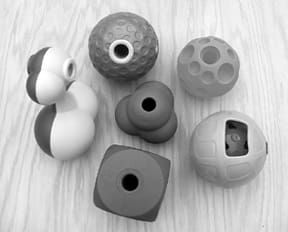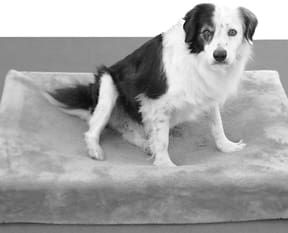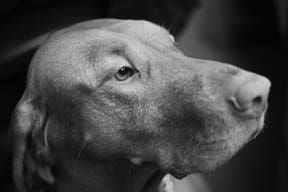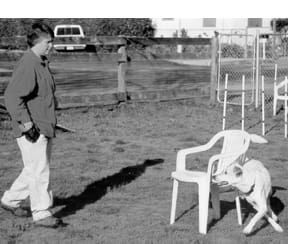Remembering what occurred in a few quick seconds on that sunny December afternoon seems like watching a film running in slow motion to Karen Scussel, co-owner of a 12-year-old terrier mix named Petey. Returning home from Christmas shopping on December 19, 2000, Karen looked forward to Petey’s usual greeting as he raced around to the drivers side of her car after she had entered the garage and turned off the engine. But, at just the moment before the garage door closed, Petey spotted a squirrel across the road, and dashed after it in typical terrier fashion.
Karen describes what happened next as Petey hitting a car, rather than Petey getting hit by a car. The terrier ran right into the side of an automobile that was passing by their house. Fortunately, the car did not run over his body, but the impact did launch him up in the air and he landed hard in the road.

Horrified, Karen rushed to Petey’s side and saw he was unconscious and bleeding from the mouth. His left eye appeared damaged. She scooped Petey up and immediately drove him one short mile to the Adobe Animal Hospital in Los Altos, California.
At the animal hospital, veterinarian Dave Roos stabilized the little dog and controlled the bleeding, then began to investigate the extent of the damage to Petey’s body. As she watched Dr. Roos care for Petey, the trauma of the events that had occurred in just the last few minutes descended on Karen. “I lost it,”she says. “The doctor’s assistant asked me for my telephone number because that’s how the animal hospital files its patient records. I couldn’t even speak to answer their questions. Because he was not responding at first to Dr. Roos’s treatments, the doctor advised Karen that Petey might not survive the accident.”
Determined guardians
Karen and her husband, Curt Riffle, first discovered Petey at their local humane society shelter in 1990. Scheduled for euthanasia the next day, the shelter considered the little dog, then four months old, to be un-adoptable. Unsure of his background, they thought he might have suffered an accident in the recent past, as he had shaved patches on his legs as though he had received anesthesia.
But Karen and Curt found his blond terrier coat and his dark brown eyes irresistible, and he became a welcome member of their family, which already included a Dachshund/Chihuahua mix named Rascal. Petey proved to be a sweet, mellow, 14-pound pet, with a low-key temperament, and no behavior or health problems. An affectionate fellow, he developed a special attachment to Karen.
As her canine friend lay unconscious in the veterinary hospital, Karen phoned her husband and told him about Petey. When Curt arrived at the hospital, the veterinarian told the couple that, although Petey’s chances of recovery were questionable, his x-rays, amazingly, revealed no broken bones. Originally concerned that Petey might have broken his back, Dr. Roos concluded that Petey suffered a severe concussion and spinal contusion, and that his injuries may have inflamed his brain. Petey had regained consciousness, but he could not see and was not able to walk or even stand. Dr. Roos could not assure Curt and Karen that their dog would ever regain his sight or mobility.
Though they were devastated by Dr. Roos’s words, Curt and Karen committed to doing everything possible to help Petey.
We were both on Christmas vacation from our jobs, Curt explains. We visited Petey at the animal hospital every day, all day, during the three days following the accident. Rascal even came to visit Petey, too. When Rascal and I saw Petey after the accident, Petey wagged his tail. That’s when Dr. Roos said Petey had a small chance to recuperate to some extent. Petey realized that we weren’t going to give up on him, so he decided not to give up, either.
In the Intensive Care unit, Curt and Karen constantly talked to Petey, and gently stroked him. Although the dog received nourishment through IVs, Karen encouraged him to eat baby food. Dr. Roos told us that Petey should be able to eat and drink before he could return home. Although his jaw was not working properly, I was determined to get him eating, and I did. On the third day following his accident, Curt and Karen brought Petey home, still blind and unable to stand, but able to eat with difficulty.
At first, Curt and Karen carried Petey outdoors, supporting him so he could relieve himself. During the first week, Petey took a few wobbly steps and his sight returned; however, Curt and Karen noticed that Petey’s body curved sharply to the left and his abdomen seemed twisted to the left side of his body. When Petey walked, he constantly turned to the left. I felt very guilty and sad to see him that way, Karen admits. I thought he must be so confused to suddenly find himself in that condition, but the doctor told us not to worry about it as Petey wouldn’t know the difference after a while.
Petey in the swim
Not satisfied with Petey’s condition after leaving the hospital, Curt decided to research holistic therapies that might be suitable. He and Karen subscribed to WDJ, but had no experience with complementary therapies for themselves or their animal companions. A horse owner, Curt did know other equestrians who were enthusiasts of holistic practices, so he thought it was worth researching for Petey.
In the October 2000 issue of WDJ, he discovered an article about hydrotherapy as a rehabilitative treatment for injured dogs, and noted that one of the hydrotherapy clinics mentioned in the article, the Animal Fitness Center in San Jose, was close to home. During hydrotherapy, the dog floats with support in a warm pool where its muscles can relax; a trained therapist guides the dog through appropriate exercises, helping the dog overcome muscle, skeletal, and nerve damage.
Curt discussed the therapy with Karen, and together they decided to let Petey try it. In late December, they brought Petey to the Animal Fitness Center for his first hydrotherapy session with Kathy Kern.
A veterinary technician and hydrotherapy practitioner for 17 years, Kathy herself experienced the healing effects of hydrotherapy after a drunk driver struck her car. She underwent shoulder surgery following the accident, but was not able to regain full range of motion or freedom from pain. A physical therapist recommended hydrotherapy, which was key to a successful recovery. Shortly after her own success with the therapy, Kern began training to become a veterinary hydrotherapist.
Petey exhibited an overall lack of circulation due to his injuries, Kern remembers. The injury interrupts the circulation and the body forms collaterals, or circulation paths around the blocked blood vessels, but these paths are not efficient and delay healing. The sooner we treat dogs after an injury, the more effective we can be, because they have not yet created too many collaterals. Petey couldn’t get his circulation going again through his injured paths because he could not support his body weight enough to exercise properly and restart his circulation.
Animals and people retain brain memory from traumas that cause them to anticipate pain from attempted movements. Floating in a pool heated to about 92 degrees, a body can relax and move in new ways that are not painful. Kern calls this process erasing erroneous pain patterns from the brain, allowing the brain to accept movement without attaching painful memories to the effort. In contrast to chiropractic, where the therapist manipulates the patients body, a hydrotherapist provides physical support in the pool, and a relaxed environment, allowing the animal to make its own adjustments.
Kern recommends one-hour treatments each day for three consecutive days to treat almost all conditions. The owners remain in the pool area during treatment, helping the dog to feel secure and focused. The treatments are as good for the owners as they are for the dog, she says. Seeing their dogs in the pool moving freely again, and without pain, encourages the owners and makes them feel good, too, says Kern.
Curt and Karen noticed that Petey’s body was much straighter after the hydrotherapy treatments. However, he still had trouble eating, drinking, using his tongue, and grabbing and holding objects in his mouth. During January 2001, Curt and Karen debated the need for additional treatments for Petey, and wondered whether Peteys current improvements represented the best recovery he could make. We had already gone beyond our traditional response to a medical situation by arranging for the hydrotherapy treatment. We weren’t sure we wanted to go overboard by layering other therapies on top of hydrotherapy, says Karen.
In January, as they pondered Petey’s condition, they adopted a third dog from the shelter. A bright and happy-go-lucky Spitz-mix they named Chloe, she seemed to help Petey to lighten up. Curt and Karen began to suspect that Petey could improve even further.
After his three hydrotherapy treatments, Kern had asked Curt and Karen to consider acupuncture to further support Petey’s healing, and to encourage the long-term recovery of his damaged nerves, both in his body and in the left side of his face. Hydrotherapy improves most muscle and skeletal conditions, traumatic and chronic, but Petey had also suffered significant nerve damage, and nerve regeneration proceeds very slowly. Kern thought that acupuncture might be just the thing for Petey.
Another adjunct
Back Curt went into his WDJ archives, and found the July 2000 issue with an overview of acupuncture. We were so pleased with the success of our first venture into holistic therapies that we were now open to learning about and trying another new therapy, if we could again enhance the quality of Petey’s life, says Karen. We made an appointment with Dr. Sarah Skiwski, who had just started practicing acupuncture at the Adobe Animal Hospital. We felt we were off on another learning adventure.
Petey’s severe left-side weakness was readily apparent to Dr. Skiwski. He had significant problems working his mouth and tongue, which seemed beyond his conscious control. On the left side of his face his muscles had atrophied from a lack of nerve impulses stimulating them, and you could see his jaw bones through his skin, reports Dr. Skiwski. Nerves take an especially long time to heal, she adds, and I knew I had to get Petey’s circulation going in his face before the muscles atrophied beyond repair.
To calm Petey, Dr. Skiwski inserted one acupuncture needle on the top of Petey’s head, in a location that aids in relaxation. She added another needle in the left side of his face. The animal relaxes, and then tells me when the treatment is finished, notes Dr. Skiwski. Usually after about 15 minutes, the animal starts to move around and acts restless. Then I know the needles have done their work and its time for them to come out.
Karen, who accompanied Petey to his sessions and held him while Dr. Skiwski placed the needles, was astounded by Petey’s reaction to the acupuncture. I could feel Petey relax as soon as Dr. Skiwski inserted the needles, Karen recalls. Then I could actually feel his body heat up and, sometimes, going home in the car, Petey would pant. I knew the acupuncture was getting things moving again. Dr. Skiwski also instructed Curt and Karen to massage Petey on certain pressure points she identified around his head. They performed this treatment at home twice a day, for two to three minutes each time.
After three acupuncture sessions, Petey showed great improvement in his ability to eat. By the fourth session, he was able to grasp his toys more tightly in his mouth. By the eighth session, much of his facial paralysis had diminished, the muscles on the left side of Peteys face had begun to fill out, and he was able to blink his left eye normally. We consider about seven or eight sessions a course of treatment, explains Dr. Skiwski. We often get resolution within that time.
Petey’s owners played a key role in Petey’s improvement, Dr. Skiwski emphasizes. They encouraged him to use his mouth by playing ball and tug with him. They didnt baby him too much it took a little bit of tough love on their part. Also, their expectations were reasonable. I told them that healing nerve damage would be a slow process, and they stuck with it all the way.
An almost total recovery
Today, Petey eats and drinks normally, plays with his Kong toy, and joins his family on long hikes in the California hills. If you know what to look for, says Curt, you can still tell that he drifts slightly to the left when he walks. But its barely noticeable. We are delighted with his recovery. Previously without any experience with holistic therapies, Karen states that now she is much less inclined to agree to invasive treatments until she has tried appropriate holistic therapies.
Curt summarized what he believes were the key ingredients in Peteys successful recovery:
Providing emotional support in intensive care: Curt, Karen, and Rascal spent many hours each day with Petey in the intensive care unit of the animal hospital. They spoke to him, touched him, and hand fed him, and Rascal licked his face. Petey knew his family would not give up on him.
Relishing little victories: Petey responded so well to each course of treatment that Curt and Karen did not become depressed or discouraged for long. They valued the small advances Petey made, one at a time. But, eventually, the small successes all added up to big improvements.
Adding Chloe to the family: A fun-loving and playful dog, Chloe helped to keep Petey alert and active during his recovery period. He herded her as she ran around the yard, and they became fast friends. Her spirit helped to heal Petey’s body, and regenerate his own spirit.
Addressing quality-of-life issues: Although the veterinary hospital provided excellent emergency medical treatment, it was up to Curt and Karen to fully research and select the therapies that could impact the quality-of-life aspects of Peteys recovery. Curts initiative in identifying holistic therapies, and Karens willingness to attempt holistic treatments, provided the impetus to return Petey to the level of health he enjoys today.
Enhancing all elements of Petey’s lifestyle: As Petey responded so well to the hydrotherapy and acupuncture, Curt and Karen decided to begin using the high quality dog foods recommended by WDJ, supplemented with fresh vegetables. We are able to keep Petey at a good weight for his structure now, said Curt. He has lots of energy for the exercise that keeps him fit.
Curt calls their experiment with holistic therapies a great adventure and learning experience that really worked. Karen agrees and adds, I’m so glad we didn’t give up on my best buddy.
-by Lorie Long
Lorie Long is a freelance writer and an avid agility competitor living in North Carolina.












